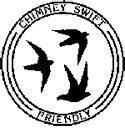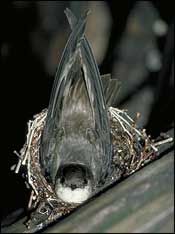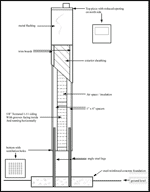Texas Partners in Flight
Providing and Maintaining Habitat for Chimney Swifts
Paul D. and Georgean Z. Kyle, Directors, North American Chimney Swift Nest Site Research Project

The summer skies are filled with many species of birds. However, none seem to be as much at home on the wing as the Chimney Swifts. While even the graceful swallows must perch to preen and socialize, the Chimney Swifts flicker on, chippering and careening endlessly throughout the day.
Small, sleek, bluish-black with silver-gray throats, Chimney Swifts have been called "flying Cigars" and "bows and arrows”. Their stiff, flickering movements alternate with long, graceful sweeps of flight as they scour the skies for flying insects. Their prey includes mosquitoes, flies, gnats, winged ants and termites. As captivating as their flight is to watch, their clandestine terrestrial behavior is even more remarkable.
Unable to perch or stand upright as songbirds do, Chimney Swifts are uniquely equipped to roost clinging to vertical surfaces. Their small but strong feet are tipped with four sharp claws which act as grappling hooks to hold them firmly to their roost. Their tail feather shafts extend as stiff exposed spines to provide additional support for their vertical lifestyle. When at rest, Chimney Swifts require the safety of an enclosed area such as a chimney, airshaft or abandoned building. It is in these inaccessible locations that they roost, build their nests, raise their families and congregate prior to migration.

The adaptation by Chimney Swifts to make use of man-made structures is a result of deforestation and the loss of large hollow trees as natural roosting and nesting sites. This ability to adapt has not only allowed Chimney Swifts to survive as a species, but it has caused their range to greatly expand. As recently as the 1940's, Chimney Swifts were rarely sighted west of the Mississippi River. They are currently found from the east coast to the foot of the Rocky Mountains.
While Chimney Swifts would seem to be an exception to the generally declining populations of migratory birds, the pendulum may be swinging back against them. Chimney Swifts commonly roost together in large numbers in a single shaft. However, each breeding pair must have a site of their own to raise their young. This has become a problem with the advent of metal chimneys and the increasing desire of homeowners to cap their chimneys. Suitable nesting sites are becoming harder for the swifts to find.
Maintaining Fireplace Chimneys
Providing nesting sites for Chimney Swifts is not as easy as putting up a prefabricated Purple Martin house or hanging out a nest box for Carolina Wrens, but it may be as simple as properly maintaining an existing fireplace chimney. Since Chimney Swifts are in North America only during the warmest part of the year, there is seldom a conflict over time-sharing rights of a chimney.
For a chimney to be suitable for swifts, the inside must be made of stone, firebrick or masonry flue tiles with mortared joints. These materials provide enough texture for the birds to cling to the walls and attach their nest. Metal chimneys are unsuitable and should always be capped. Any animal that enters a metal flue will fall to the bottom and be unable to climb the slippery walls.
Proper maintenance is crucial for any chimney whether it is to be used by Chimney Swifts or for winter fires. Wood fires produce flammable creosote residue that coats the inside of a chimney. If left unattended, this material will build up and the entire layer may ignite. A resulting chimney fire will spew burning cinders onto the roof and surrounding structures. In most cases, an annual cleaning by a professional will keep the chimney walls clean and safe.
Chimney Swifts build their nests by attaching small twigs to the chimney wall with their glue-like saliva. When completed, the shallow half-cup nest protrudes two to three inches from the wall. By keeping the chimney free of creosote build-up, homeowners help assure successful nest building, decreasing the chances of the nest falling before the birds have fledged. The best time to clean a chimney is in mid-March when the wood fire season is over and just before the Chimney Swifts return from their Amazon Basin wintering grounds.
When cleaning the chimney, the damper should be inspected and should remain closed during the nesting season. This will prevent birds from accidentally flying into the house and becoming trapped or injured. A closed damper will also prevent a nest that does break loose from falling into the fireplace. It also lessens the transfer of sound and will make the chimney quieter for the birds and homeowner. In older homes some fireplaces may not have dampers, or they may be inoperative. In these cases, a large piece of foam rubber (do not use fiberglass insulation) can be wedged up from the fireplace to serve this purpose, while the swifts are in residence.
Providing New Nesting Habitat
It is possible to construct habitat specifically for Chimney Swifts. The most elaborate project of this kind was designed and built by Althea Sherman in 1915. This Chimney Swift Tower was nine feet square and twenty-eight feet tall. In the center was a two-foot square chimney that ran to a depth of fourteen feet. The artificial chimney was made of rough-sawn lumber, and was equipped with viewing ports and auger holes for observing and recording the home life of the Chimney Swifts.
Considerably less ambitious attempts have produced artificial chimneys that have been readily accepted by Chimney Swifts. In central Texas numerous towers have been erected in recent years. Many of these more modest structures have attracted nesting pairs of swifts the first year they were in place. Several have even been used as colonial roosts and have consistently attracted flocks of more than one hundred individuals in the late summer and early fall. Modern building materials place the project within the capabilities of most "do-it-yourselfers”.
Tower Design Basics
Dimensions
Chimney Swifts require a shaft that is at least eight feet deep and closed at the bottom. They will generally build their nest in the bottom 1/3 of the tower to protect their young from direct sunlight and rain showers. A minimum internal diameter of fourteen inches is adequate. Larger and deeper towers are also more attractive to swifts as communal roosts.
Materials
Rough texture on the inside is essential. An excellent material is 5/8” Textured One-eleven (T1-11) siding. It is rough-textured plywood with 1/2” grooves spaced every four inches. It is available from most lumberyards in 4’ x 8’ sheets, and can be cut into conveniently sized panels. Facing the textured surface to the inside of the tower and running the grooves horizontally creates footholds for the birds. The swifts are able to hold onto the entire surface of this material, but they seem to prefer lining up side by side on the grooves. Another excellent material is concrete cinder block -- although more expensive and difficult to work with, it creates a more permanent structure. The inside mortar joints should be left “sloppy” to provide as much rough texture as possible.
Construction
An air space between the inside chamber and the outside skin of wooden towers will prevent over-heating (a common problem with smaller towers). The space should be filled with a rigid insulation board.
A bottom with a grid of 3/8” ventilation holes spaced 1” apart keeps the inside darker and more attractive to swifts. It also protects against predation. If installed with several screws, the bottom can be easily removed for cleaning and inspection in the fall.
Towers should be fitted with a “sun collar” on the top, north-facing edge to protect the eggs and young from direct sunlight.
The outside of the tower should be finished with a light-colored paint or stain to reflect heat and protect it against the elements. However, the inside should be left unfinished to retain the rough texture of the wood.
Placement
Stabilizing the tower is important. The easiest method is to attach the tower to an existing structure. The north or east side of a building is preferable because the tower will remain cooler in the summer.
The top of the tower should
extend four to six feet
above the roof of any adjacent
structure. This will make
it obvious and accessible
to Chimney Swifts but not
to predators such as cats,
raccoons and opossums. A
predator guard is highly
recommended: 24 inches of
metal flashing around the
top.
A freestanding tower on
legs is easier to protect
against mammalian predators
and ants. It should be
located in a small clearing.
For an 8’ tower
imbed the legs in a foundation
measuring 36” x
36” x 6”.
For a 12’ tower
pour a foundation measuring
48” x 48” x
8”. Steel rebar
or remesh will greatly
increase the strength
of the foundation.
Towers should be cleaned of droppings and old nests each fall after the swifts have migrated from the area. A cover may be placed over the top during the winter to protect the inside of the tower.
Chimney Swift Nest Site Research Project
(PDF 166.4 KB)
For more information about Chimney Swift conservation , please contact:
Paul and Georgean Kyle
c/o Driftwood
Wildlife Association
1206 West 38th, Suite 1105
Austin, Texas 78705
(512) 266-3861
